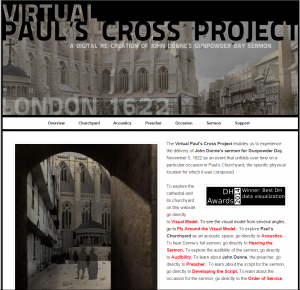It is unfortunate that many historical buildings have been demolished and cannot be appreciated by people around the world. With digital humanities, buildings that do not exist today can be replicated virtually in terms of visuals, sounds, and other factors. A great example of this is the Virtual Paul’s Cross Project, which shows John Donne’s Gunpowder Day sermon as it would have happened back then.
The project used many different sources for the foundation of the project. Maps, sketches, and drawings of the church were used to make the visual representation of the church. Historical accounts, transcript of sermons, and records were found to recreate the information about the preacher and hearing the sermon. Lastly, drawings, weather data, and paintings were needed to produce a portrayal of the outside and the surroundings of the church.

Visual Model of the Church
The first process that took place was scanning in all of the maps, sketches, drawings, paintings, transcripts, and records. Then data from the documents was used to create an acoustic map. The accounts and records of the sermons were compiled and synthesized to recreate the service and information about the preacher, Donne. Also, the average weather and the size of crowds were calculated based off of weather data, maps, and sketches.
Now that all of the information and data had been processed, computer programs were used in order to display the information. To make the visual model of the church, Google SketchUp was used along with Photoshop to make the images more accurate. The acoustic representation of the sermon and the crowd was made with the CATT acoustic modeling program. Also, some web development tools or builder was used for the production of the website, however, the specific product used was not mentioned on the website. The Virtual Paul’s Cross Project is a superb example of the power of digital humanities and the process used in order to create the project.

I agree with you that it is unfortunate how historical sites no longer exist. But it is also fascinating how DH is now being used to help us obtain a glimpse into historical sites. I enjoyed your thorough analysis of the DH project, it is succinct, which is easily understood by anyone.